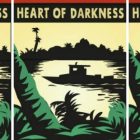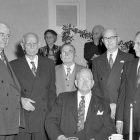The Contemporary Epic
I promised you Lonesome Dove, but we’re going to start with Derek Walcott’s Omeros, because this is a family of contemporary epics. Giant, sprawling books, full of gods and families, generations and cycles, books that seem like they go on forever and seem like they should. And where better to begin than a retelling of the Odyssey?
Omeros is a poem, or a novel in poetry. It is the only one of these books that takes the form of a classical epic, and it is full of Greek myth and Greek references, but not exclusively. Look at how Walcott does thunderstorms: “For the gods aren’t men, they get on well together, / holding a hurricane-party in their cloud-house, / and what brings the gods close is the thunderous weather, / where Ogun can fire one with his partner Zeus.” Greek and African myth in one stanza, and over the course of the book there are several kinds of Christianity, some ancient Egypt, a canoe that’s a tree-god, and more. Walcott jams the history of three continents onto one tiny Caribbean island—and of course, that’s exactly the point.
Larry McMurtry’s Lonesome Dove is a different kind of epic. No poetry, and no gods, either. No references. If Omeros is about fullness (over-fullness), Lonesome Dove is about emptiness. It’s the story of a cattle drive from Texas to Montana, full of death and terror and machismo. But goddamn, is it beautiful. I have never read a fuller evocation of the American landscape, and bear in mind here that I am a sucker for Steinbeck. Lonesome Dove does it best.
Put these two books together, and you get three very different results. First there’s Eleanor Catton’s Booker winner The Luminaries, about a mining town in New Zealand governed by the zodiac, or else about the zodiac as enacted by the inhabitants of a mining town in New Zealand. If you prefer Old World to New, there’s Graham Swift’s Waterland, in which he makes a small town in East Anglia the center of a generational saga that he uses to question the nature of time and history, and in which he somehow makes eels a metaphor for everything.
And then there are Roberto Bolaño’s two monsters, 2666 and The Savage Detectives, which I will break down like this: 2666 is about death and The Savage Detectives is about poetry, but Bolaño handles them the same way. He overwhelms the reader with deaths and with poets. There are too many to remember. We’re back to over-fullness, to references upon references, note the re- in reference and remember. To me, is one of the main characteristics of the contemporary epic. All these books circle back. There are always more myths in Omeros, more eels in Waterland, more murdered women in 2666. Time blurs. Characters blur. These stories are bigger than we can understand.
On the other side of the family tree, we have social realism, or something like it. If Omeros snuck around with Money, Martin Amis’s massive, comic attack on the 1980s, they would produce Marlon James’ new novel, A Brief History of Seven Killings, which is, you know, not brief. A Brief History of Seven Killings is physically big and intellectually enormous. There’s money and gangs and crack and reggae and decades of Jamaican history. There are ghosts. There is some truly beautiful use of patois. A Brief History of Seven Killings overflows with characters, with language, with fear. It may not be a quest story, or have a single hero, but it’s an odyssey.
Now let’s leave behind the Caribbean, and ghosts (I did say realism, after all), and fiction. Let’s talk about the American city. At the end of A Brief History of Seven Killings, James goes into the Jamaican Diaspora, into a New York not so far from the one where Amis’s protagonist John Self spends his money. Amis writes about drugs incidentally; James writes about the crack wars, the connections between New York and the Caribbean. And Adrian Nicole LeBlanc, author of Random Family, spent eleven years with a family in the Bronx—some of its members related, some not—who she first encountered when covering the trial of a successful young heroin dealer named Boy George. She takes us so deeply into her subjects’ lives that it seems almost impossible that they could be real: she knows them so well, I have found myself thinking, that she must have made them up.
There are characters on The Wire who are real and made up at once: based on real Baltimoreans, but brilliantly written and brilliantly acted. There are characters on The Wire who we forget aren’t real. Omar turns up in Eminem lyrics, and the actor who played Bubbles once got stopped on the street by another actor, who congratulated him on the role and hoped he would take the opportunity to get clean. I occasionally tell people that The Wire is the best novel of the twenty-first century. I want everyone to watch it. There are few works of art as challenging, as intricate, as empathic, and, frankly, as informative as The Wire. And unlike most of my contemporary epics, The Wire has a true hero: the city of Baltimore. Go watch a few seasons. Read Lonesome Dove in between. Believe me, they’re both quests.




